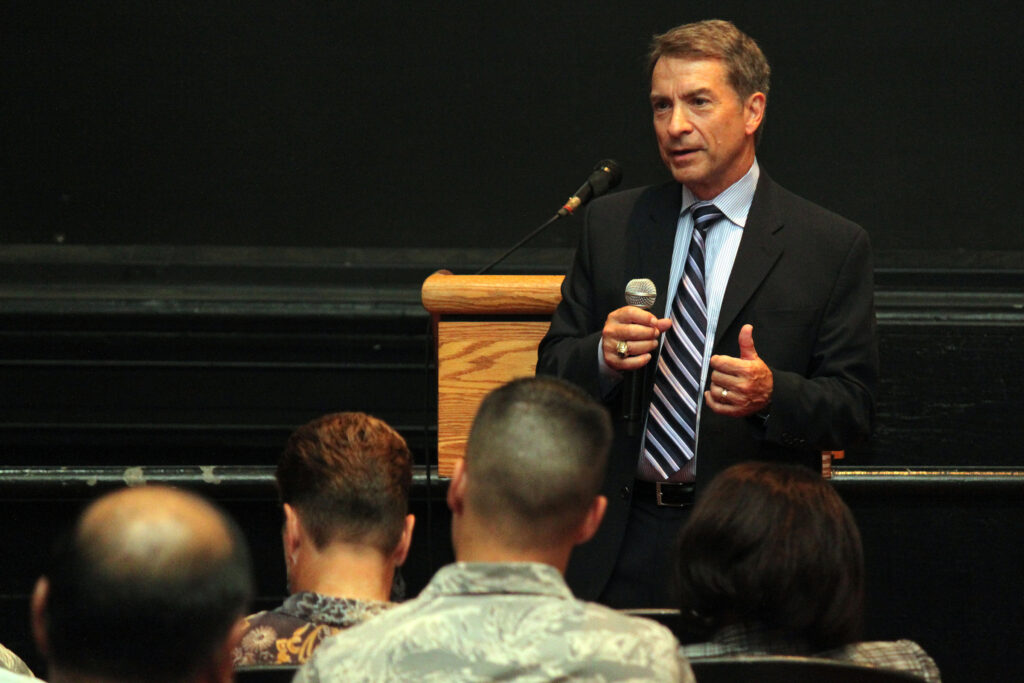By THERESA HITCHENS
 WASHINGTON: DoD will solicit vendors to undertake experiments to integrate high-speed 5G wireless connectivity into operations at four military bases sometime this quarter, Pentagon officials said today.
WASHINGTON: DoD will solicit vendors to undertake experiments to integrate high-speed 5G wireless connectivity into operations at four military bases sometime this quarter, Pentagon officials said today.
The test program involves one base for each service, Dwayne Florenzie, senior strategy exec at the Air Force’s Office of Commercial and Economic Analysis, told an audience this afternoon at a conference on 5G cosponsored by law firm Venable and The Potomac Institute. “That was purposely done,” he explained, “so that we do share the information and lessons learned from each other.”
The first experiment will take place at Hill Air Force Base in Utah, and will involve spectrum sharing, he said. Then “test environments” will be stood up at McChord AFB in Washington (the main base for the Army’s C-17 fleet), which will involve using 5G to enable virtual reality training, and at the Marine Corps Logistics Base in Georgia and Naval Base San Diego where 5G connectivity will be used to speed depot and warehousing activities.
The 2020 National Defense Authorization Act, signed into law on Dec. 20, approved $275 million for the DoD-wide 5G research and development effort, and the creation of the test sites.
Meanwhile, the Air Force is moving forward with its ambitious plan to wire its bases to eventually enable 5G communications at 17 more bases in the Northwest, having recently issued a request for information encouraging interested telecommunications firms to offer commercial LTE 4G services as a precursor, said Chief Technology Officer Frank Konieczny. A decision on which telecommunications company will win the contract will be made sometime this quarter, he added.
As Breaking D readers know, the Air Force launched its 5G effort by wiring 10 bases in the Southeast region, via a contract for commercial services with Verizon. Konieczny said that network installation at those 10 bases now has been completed.
Both efforts are part of DoD’s overarching strategy — led by a new 5G office announced by DoD research and engineering head Mike Griffin in August –– to enable rapid, near-real-time voice, data, video streaming and Internet of Things (IoT) applications to meet the demands of future multi-domain operations.
Tim Grayson, director of DARPA’s Strategic Technology Office, said his office is trying to push forward the ability of the US military to connect, securely, anywhere around the world — even if they are forced to use one vendor from another country that “has a lock” on the market. (Read Huawei and China.) This means, he explains, trying to develop new technology that “translates” from one communication standard to another.
“We’re pushing this theme of ‘come one, come all,’ heterogeneity and federated approaches,” he said. “How can we build networks out of various different networks?”
DARPA’s 5G efforts are part and parcel of its focus on developing technologies for multi-domain operations (MDO), with an emphasis on machine-to-machine learning and software systems that allow rapid decision-making. As readers will recall, DARPA calls this effort ‘Mosaic warfare’ that is designed to create “kill webs” — rather than kill chains — that are highly resilient to enemy attack.
“i’ve got to be able to create what amount to virtual data links between military systems, using whatever communications fabric is available,” Grayson said. “My office has already been doing programs looking at purely military tactical networks, and how I build a network of networks out of individual piece parts.”
No comments:
Post a Comment